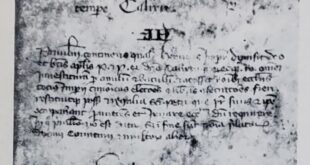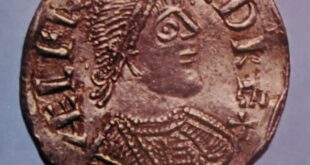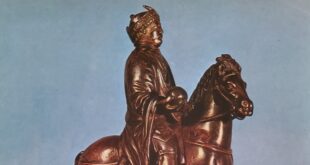The Arian threat occured in the fourth century, which opened with the triumph of Christianity in the Roman Empire, closed with the beginning of the Dark Ages. Leaders of the barbarian tribes, massing outside the Empire’s frontiers, had already infiltrated their agents into the high places of imperial politics. The old order of Roman imperial administration, already severely weakened in the late third century and only partly restored by the reforms of Diocletian, was gradually disrupted during the years following Constantine’s death. Thus, the gulf between the East, where the imperial system continued and the West, where conditions of virtual anarchy came to prevail, can be clearly seen. The breakup of the West into a number of smaller units was already in prospect. The main subject of this passage will be events in Europe and the Eastern Roman Empire, but at the same time, things were happening outside Europe in some cases parallel to European history, in others, dramatically different from it.
The World of the Orient
In the Far East, the once-great empire of Han China had fallen apart in the early third century and China was long, to remain in a state of political turmoil. Then came the establishment of the Tsin dynasty in the year 265 and about this time, a new force was beginning to make itself felt in northern China. During the fourth and fifth centuries, meanwhile, the Tsin were to extend their power into the southeast and a new era, in Chinese social and cultural history, was inaugurated.

At first the Tsin power in the north had been severely curtailed by the incursion from beyond the frontiers of Hunnic tribes from central Asia. A number of warring barbarian dynasties were established in the north, but they were supplanted in about 430 by the new northern Wei dynasty.
The great unitary Chinese empire seemed a thing of the past. Despite the turmoil that preceded the foundation of the Tsin, the so-called age of the Three Kingdoms in the third century, was regarded by succeeding generations as an age of chivalry, commemorated in the great Romance of the Three Kingdoms. Moreover, despite the continuation of civil war and foreign invasion, the fourth century witnessed a revival of cultural life and significant technical advances. The native Chinese religious philosophy of Taoism enjoyed a new vogue and the pacific cult of Indian Buddhism, made considerable advances. It may well have been in a spirit of resignation that people in the war-torn land of China, sought refuge in the Taoist ethic, one that rejected personal striving and endeavour, and held that it was the function of the ruler to provide the minimum of good government necessary for peace and order. The tenets of Confucianism, based on a fully administered and well-ordered state, were in full retreat.
It was not for many centuries to come, that the links of trade between China and Europe were to re-establish a degree of contact between the two civilizations. It is important to notice that, although remote from one another, both Europe and China suffered the same scourge in the depredations of the Huns. Failing in their attempt to overrun the whole of China, these nomadic warriors retreated to the steppes of central Asia, from which in the fifth century, they were to descend on Europe.

The hordes of nomadic barbarian tribes known collectively as the Huns, were the scourge of civilization, in several areas during the fourth and fifth centuries. Roughly contemporary with their attacks on China were their invasions of northern India, which became intensified during the fifth century. At first, these troubles on India’s northern border did not seriously disturb the course of a period of peace, prosperity and unity that may justly be regarded as the golden age of ancient Indian civilization. It was the age of the Gupta dynasty, which established itself in the north in A.D. 320, just four years before the Emperor Constantine asserted his sole rule over the whole Roman Empire.
In the first fifty years of their dynasty, the Guptas unified the whole of north and northwest India and were soon to gain the homage of the states of the south. The climax of this age of unity and cultural advances came in the reign of Chandragupta 1 (380-415). The prosperity of his empire is described in the diary of the Chinese Buddhist monk Fa Hsien, who was in India from 405 to 411, to research and collect Buddhist and other religious texts. Chandragupta and his successors promulgated a code of law for the whole subcontinent and sent ambassadors, as far afield as Rome. This was also a golden age for the arts; it witnessed the beginnings of the mural paintings in the Ajanta caves and the career of the Sanskrit dramatist Kalidasa.

Just as China had been subject to the religious influence of Indian Buddhism, so during the fourth century was her civilization also enriched by contacts with Persian, as well as Indian traders. Like India, Persia enjoyed a period of great power and prosperity during the fourth century, under the rule of the Sassanid dynasty. Ever since the founding of their power and the capture of Ctesiphon in 220, the Sassanids had successfully established their ways throughout Persia and had extended their influence beyond their frontiers, even defeating the armies of Rome. During the reign of Shapur II (309-79), Persia continued to offer a Major threat to the eastern frontiers of Rome, which suffered another major setback, when the Emperor Julian the Apostate, was defeated and killed in battle in the year 363. The conflict between the two empires, which was centered upon the border state of Armenia, was temporarily resolved by the partition of that country in the last decades of the fourth century. The Armenians had accepted Christianity and consequently were subject to persecution by their Persian rulers, a pretext for the intervention of eastern Rome in the future.
The Arian Heresy and Threat
When Constantine followed up his victory at the Milvian Bridge with the Edict of Milan, a new era in European affairs opened. As we have seen, the edict did not make Christianity the official religion of the Empire; but the sturdy and well-organized Christian Church, achieved a new status that it fully exploited during the coming century. Constantine used the growing power and influence of his new ally to further his own ends. He saw his own authority encompassing ecclesiastical affairs. After his victory over the ambitious Licinius, which made him the sole arbiter of the Empire, he had convened the Council of Nicaea, the first general council of the Church, which decided many important matters of faith and Church administration. Ex officio, the Emperor had always held the office of pontifex maximus. the ultimate authority in the religious affairs of the Empire, and Constantine had no intention of surrendering this important attribute of his predecessors. Yet by linking the hierarchy of the Church to that of the civil administration, Constantine not only reinforced the one by providing it with a powerful spiritual ally, he also strengthened the other by giving it influence beyond its spiritual concerns.

Yet, it was in the spiritual field, that the Church really exercised her power. By the end of the century it had almost usurped the ancient authority of the imperial pontifex maximus. The climax came in the reign of the Emperor Theodosius, who was forced to seek public absolution from St. Ambrose in the cathedral of Milan.
Three points had been at issue: who was to be the final arbiter in matters of faith, Church or Emperor? If Church, was the claim of the bishops of Rome to supreme authority in the universal Church to be allowed? Finally, how was faith to be defined? The Church was involved in a struggle for power with the Emperor, but it was also at odds with itself.
As the Church emerged from the shadows of governmental disfayour with the Edict of Milan, it revealed a bewildering number of conflicting views on the nature of the faith and above all, on the nature of Christ. The most general view was that Christ, despite his human manifestation, was of the same substance as the other members of the Trinity, a mystic and indivisible unity. Yet it was the opinion of an Alexandrian priest, named Arius, that God the Father had created Christ, the Son who, although the first being of creation, was not equal with the Father. The Arian heresy, perhaps the most serious threat to the faith of Christendom before the Reformation, spread so widely in the eastern parts of the Empire, that it endangered civil as well as religious peace. It was to meet this threat that Constantine had convened the Council of Nicaea and it was there that Roman Catholic orthodoxy found its champion in the figure of St. Athanasius. Although Nicaea proclaimed the Trinitarian doctrine, Arianism remained strong throughout the century; the barbarians adopted it as they came within the orbit of the Empire, and even some Emperors were among its adherents.

Throughout the centuries of religious dispute, the bishops of Rome held firm in their opposition to Arianism. As early as the reign of Pope Julius I (337-52), they were pressing their claim not only to seniority among the patriarchates of the Church, a claim by the city of St. Peter that was not denied by Antioch or Alexandria, but also to the supreme authority in matters of faith. Their claim was strengthened during the reign of Pope Damasus I (366-84), when Valentinian I, the Emperor of the West, decreed that all religious disputes should go to the Pope and still more significantly, when Theodosius as Emperor in the east officially condemned Arianism and made belief in the equality of the members of the Trinity the test of orthodoxy.
With Theodosius’ decree “De Fide Catholica” of 380, the doctrinal position of Rome was vindicated by imperial authority, but the Church in the West, did not in any way accept this as vindicating imperial claims to authority over it. On the contrary, St. Ambrose preached openly that the Emperor was in the Church and not above it. When, therefore, Theodosius found himself excommunicated for his brutal repression of the citizens of rebellious Salonika, he was obliged to make formal public confession of his “sin” before he could regain admission to the sacraments.In matters of doctrine and quite sensationally, in matters of Christian discipline, the Western Church had by the end of the fourth century, made good even its most grandiose claims. Although the Arian heresy survived for centuries in the barbarian kingdoms, it had been branded as heresy and the Roman position had been upheld. Later, in the Middle Ages, the popes of Rome were to find their position threatened by the secular power, but that position and its authority had been unequivocally stated as early as the fourth century. In the generation of upheaval and turmoil that followed in the West, the spiritual rulers at Rome were to be the only unbroken link with the glories of the imperial past. Thus, when new kingdoms emerged after the barbarian invasions, they received their Christianity, their passport to the new Roman civilization, from the Church. They found themselves confronted by a sophisticated and mature diplomatic and political body in the papal chancery. A body that so controlled the “commanding heights” of civilization that it could hardly be seriously challenged on its own ground.

Under Gregory I the temporal power of the popes was firmly established. One of his greatest successes was the conversion of England, which Gregory entrusted to St. Augustine. The light of faith had never, in fact, been completely extinguished in Britain and the Celtic Church, which survived in Ireland, Scotland, Wales and Cornwall, represented a tradition dating from the first or second century. The Celtic Church kept faith and learning alive. Celtic culture flourished at a time when civilization seemed, in many places, to be in retreat.

























